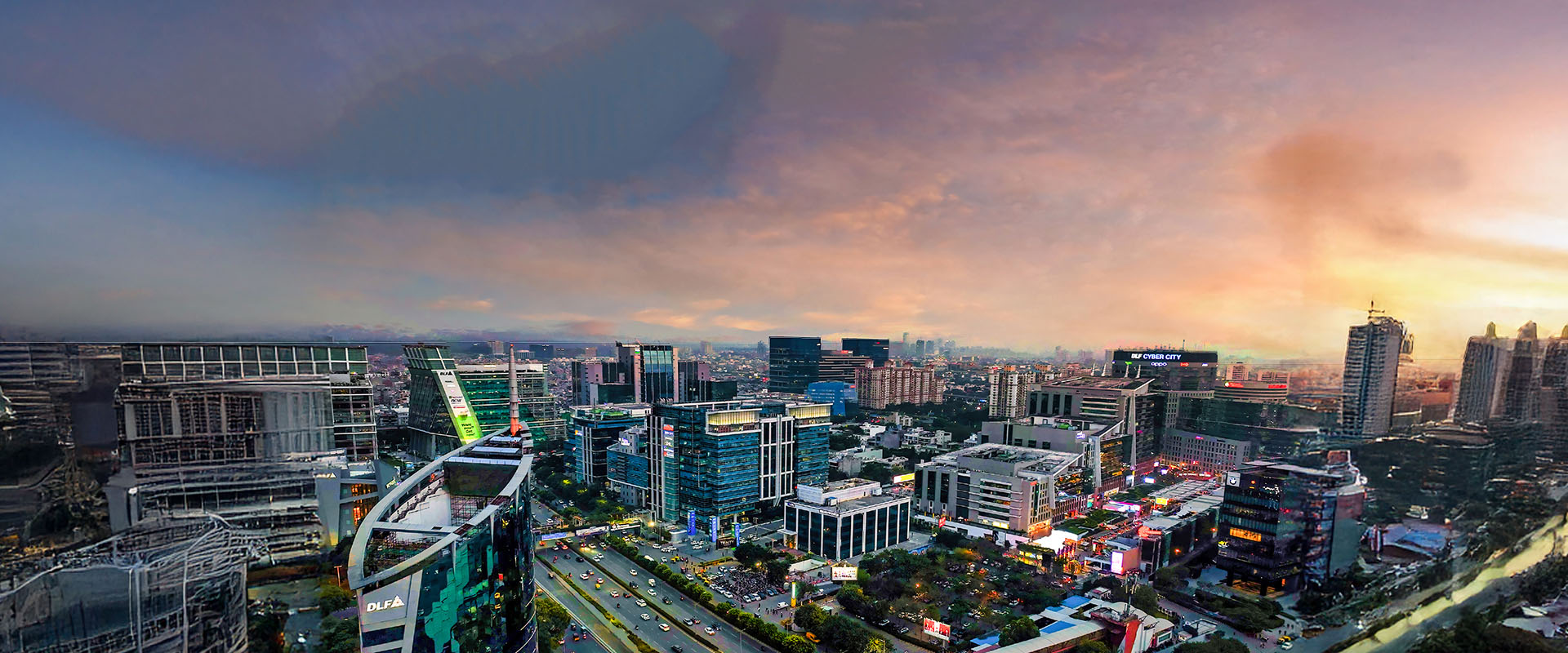Gurugram or Gurgaon, as many still call it, is often sold as India’s “Millennium City” and corporate powerhouse. Home to some of the world’s biggest companies, including Coca-Cola, EY, Hero MotoCorp, Apollo, Max, and Fortis, the city contributes nearly 65% of Haryana’s income tax collections. Its skyline is defined by luxury condos, glass towers, and gated communities that can rival Manhattan’s skyline.
And yet, behind this corporate gloss lies an ugly truth: Gurugram suffers from slum-like infrastructure, broken drainage, disappearing rivers and wetlands, waste-choked roads, and civic bodies that seem perpetually asleep. Foreign nationals and expats who chose to make Gurugram their home are now joining local residents in citizen-led cleanliness drives, cleaning the streets with their own hands in what should be the government’s job.
It is, frankly, an embarrassment. In a city where a single apartment costs not less than a crore, residents often wade through knee-deep water during the monsoon. Roads turn into canals, cars float, manholes gape open, and traffic snarls stretch for eight hours. Gurugram, marketed as India’s global city, is today closer to a global slum.

Volunteers at work at Guru Dronacharya station on MG Road, doing work of the Municipality. Of course these actions can't fix the problem, but hopefully creates awareness and puts pressure on the municipality to do their job! @MunCorpGurugram @dc_Gurugram @PMOIndia @narendramodi pic.twitter.com/Zf1ghjtuyT— Sanjiv Kapoor (@TheSanjivKapoor) August 24, 2025
A Rare Moment of Unity: Citizens and Expats Take the Broom
On August 24th, Gurugram witnessed a rare show of civic unity. Expatriates from Serbia and France, along with local residents, launched a citizen-led cleanliness drive near the Guru Dronacharya Metro Station. The site, once a dump of unattended waste, was cleared by volunteers who donned gloves, unclogged drains, and urged others to act responsibly.
Supported by the NGO Garbage Free India, the drive was as much about symbolism as it was about action. French resident Mathilde R. explained:
“It’s not about one symbolic day of cleaning. It’s about building a culture of responsibility where every resident, local or expat, understands that the streets are shared spaces. You don’t throw garbage in your living room; the city should be no different.”
Serbian national Lazar Jankovic echoed her sentiment with Gandhian simplicity:
“Cleanliness is next to godliness. I am not asking people to join me on city-wide clean-up drives. Simply keeping the two metres in front of your house or shop clean is enough. If everyone does that, the city will automatically stay clean.”
Local residents joined in too, but their participation was tinged with frustration. Aman Verma from Sector 47 pointedly said:
“Gurugram is not Kudagram. Keeping it clean is a collective responsibility. Without citizen support, no system will work. This initiative is not just symbolic. It is a statement that we, the people, are ready to act.”
On social media, however, the mood was sharper. Netizens blasted the municipal administration and the BJP-led government. One user tweeted: “If citizens can manage it, why are civic bodies sleeping? Salaries for what?” Another remarked bitterly: “The shameless public litters without thought and the useless administration paid to clean will feel no embarrassment.”
But the larger question remains: Why should citizens and foreign nationals have to step in to do the municipality’s job?
🚨 Foreign Nationals Along With Indians Cleaning The Roads and Drains in Gurugram
Hope This Becomes a Wake Up Call For Central Government and Municipal Reforms
Shameful For Gurgaon Municipal Councilpic.twitter.com/Z8N7IyKDiy— Pragati (@pragatijainf) August 25, 2025
The Embarrassing Contradiction: Luxury Towers and Flooded Roads
Gurugram is a paradox. Inside the gated walls of luxury condos like Aralias and Magnolias, residents enjoy infinity pools, gyms, and manicured lawns. Step outside, however, and the reality is shocking: broken sewage lines, garbage heaps, traffic chaos, and roads that flood with just half an hour of rain.
Investor and long-time resident Lloyd Mathias summed it up bluntly:
“Virtually no sewage systems, no drainage, filth on the roads, and barely any public transport. Power transmission is so bad that almost every condo has backup generators. And sanitation collapses with just half an hour’s rain.”
And yet, real estate prices keep soaring. Along the Dwarka Expressway, property rates have doubled from ₹9,434 per sq. ft in 2020 to over ₹18,600 in 2024. Nearly ₹1 lakh crore worth of projects have been launched in recent years despite recurrent flooding. Investors and developers bank on Gurugram’s corporate pull and proximity to Delhi airport, ensuring demand stays high even as civic life crumbles.
This absurd contradiction — rising real estate on sinking civic infrastructure — is what makes Gurugram the poster child of India’s urban planning failure.
Shameless , whole sector 69 area is mess , they will built road in a way that it breaks in 2 months to get a new contract. Should not someone look at corruption. #gurgaon https://t.co/312HawFr40— pranav tiwary (@pranavpravi) August 25, 2025
The Ecological Cost: Vanishing Rivers, Wetlands, and the Aravallis
Gurugram’s civic mess is not just about lazy governance. It is the direct consequence of decades of ecological destruction. Once upon a time, Gurugram’s landscape was defined by the Sahibi River, Aravalli forests, wetlands, and seasonal streams. These natural systems absorbed excess rainwater, replenished groundwater, kept floods at bay and protected the city from desertification.
Today, that balance is gone. The Sahibi River has been reduced to the Najafgarh drain. Five of six ponds in Basai village were buried under construction by 2019 in just 12 years. The Aravallis, despite Supreme Court protection, continue to be ravaged by illegal mining and encroachments. An entire hillock near Bandhwari disappeared in 2020 for farmhouse construction. Wetlands that once supported biodiversity have been paved over for residential sectors and schools. Deforestation has invited dust storms from the Thar, worsened air pollution, and stripped Gurugram of its natural shield against flooding.
Gurugram’s drainage is crippled. Rainwater has nowhere to go but the streets. Even a 50 mm downpour floods the city, while 133 mm of rain recently brought it to a standstill.
Civil servant J Sanjay Kumar put it simply:
“Remove the concrete jungle, let water percolate. Plant trees to absorb excess water. Protect wetlands. Noida has better green cover, and that’s why it handles flooding better than Gurugram.”
Instead, Gurugram continues to choke on dust storms, drown in floods, and lose what little green cover remains.

On the tongue it’s Gurgaon, on paper it’s Gurugram, but in reality it’s just Garbagegaon. pic.twitter.com/hGHIbZFrxC— Nitish Bharadwaj (@HarUniversity) August 25, 2025
Suhel Seth’s Scathing Indictment: “Global City or Global Slum?”
No one captures Gurugram’s contradictions more sharply than author and entrepreneur Suhel Seth. Speaking on multiple platforms, Seth has called Gurugram’s infrastructure “slumlike” and “a shame on the country.”
“It has expensive apartments with the poorest infrastructure, and it is a blot and a shame on India’s desire to be a global player. Every passing day, Gurugram is sinking, and dragging Brand India down with it,” Seth said.
Underlying all this is a deeper malaise: outdated urban planning. Suhel Seth described it as a “1947 mindset.” Comparing India’s planning with China, he ridiculed how India still builds with a “1947 mindset,” while Beijing plans airports for 2040. He slammed Gurugram’s unplanned growth, calling it the result of opportunistic expansion, not vision:
“It didn’t grow because of planning. It grew because GE and Genpact came in first for back-office operations. The city boomed around that, not planning.”
On Delhi-NCR’s chronic flooding, he quipped sarcastically:
“It’s the only place on the planet that can boast of two Venices side by side. Gurugram and Delhi. Every year, without government help, we create a Venice for people to enjoy.”
Seth has demanded accountability, reform, and a complete overhaul of urban leadership, warning that India has become “a country of sufferers.”
If it was any other country, including the neighboring East Asian countries, the state would have hanged its head in shame.
It’s unbelievable that despite so much outrage and a complete failure of the state government in Gurgaon under the grossly incompetent @NayabSainiBJP,… pic.twitter.com/BhG4hZmQuK— Hims 🪷 🚴 🌱 🧘 (@maveinlux) August 24, 2025
Who Is Responsible? Citizens, Civic Bodies, or the Government?
The Gurugram story raises uncomfortable but urgent questions:
-
Why should residents paying crores for their homes and lakhs in taxes suffer flooded basements, live wires in waterlogged streets, and garbage piles at every corner?
-
Why are civic bodies — flush with revenue windfalls — failing to provide even basic services like drainage, waste management, and public transport?
-
Why are citizens themselves not more responsible, when many meticulously clean their ₹4-crore apartments but casually dump trash outside their gates?
The truth is, all three are guilty:
-
The government for negligence, poor planning, and lack of accountability.
-
The civic bodies for inefficiency, corruption, and indifference.
-
The citizens for hypocrisy — keeping homes clean but treating public spaces like dumping grounds.
Until all three fix their roles, Gurugram will continue to be India’s “global embarrassment.”
#Gurgaon #Gurugram
- मिलेनियम सिटी को साफ करने की विदेशी और भारतीय युवक-युवतियों ने मुहिम छेड़ी।
- गुरु द्रोणाचार्य मेट्रो स्टेशन के आसपास कचरा इकट्ठा किया।
- लोगों से सड़कों पर कचरा नहीं फैंकने की अपील की।#Lets_Clean @cmohry @NayabSainiBJP pic.twitter.com/nsI06iwIhu— DEEPAK AHUJA (@DEEPAKKAHUJA) August 24, 2025
Can Gurugram Be Saved?
Despite the anger, despair, and embarrassment, there is still a chance. Gurugram is not short of money, talent, or corporate clout. What it lacks is political will, scientific urban planning, and a sense of shared civic responsibility.
Rebuilding the city’s dignity requires:
-
Restore ecology: Protect the Aravallis, revive ponds and wetlands, and enforce strict bans on illegal mining and encroachments.
-
Modernise civic planning: Use technology and long-term design, not 1947-era patchwork. Build drainage for future rainfall realities, not past averages. Expanding public transport and reducing reliance on private cars. Installing adequate waste segregation and collection systems.
-
Stricter laws: Strict enforcement against illegal dumping, mining, and encroachments.
-
Civic participation: Citizens must stop littering, segregate waste, and pressure authorities to act. Civic pride cannot be outsourced to NGOs or expats with brooms.
Until then, Gurugram will remain a city of contradictions — luxury towers rising over flooded streets, corporate offices beside garbage dumps, and billion-dollar firms surviving in what Suhel Seth rightly calls a “global slum.”
Can there be a bigger shame than this for India?
Despite having one of the richest Municipal corporations, triple engine BJP Govt , foreign nationals had to step up and go on a cleaning drive in Gurgaon along with locals. 🤦🏻 pic.twitter.com/XSVUwU0P7n— Roshan Rai (@RoshanKrRaii) August 25, 2025
Final Word
Gurugram is not just Haryana’s problem. It is India’s mirror. A reflection of how we celebrate GDP growth and real estate booms while ignoring the fundamentals of civic life: clean water, working drains, public transport, breathable air. The August 24th cleanliness drive was a symbolic reminder that people can act. But symbolism will not fix systemic collapse.
As Suhel Seth put it bluntly: “We’ve become a country of suffering and sufferers.” Gurugram deserves better. India deserves better.
With inputs from agencies
Image Source: Multiple agencies
© Copyright 2025. All Rights Reserved. Powered by Vygr Media.


























